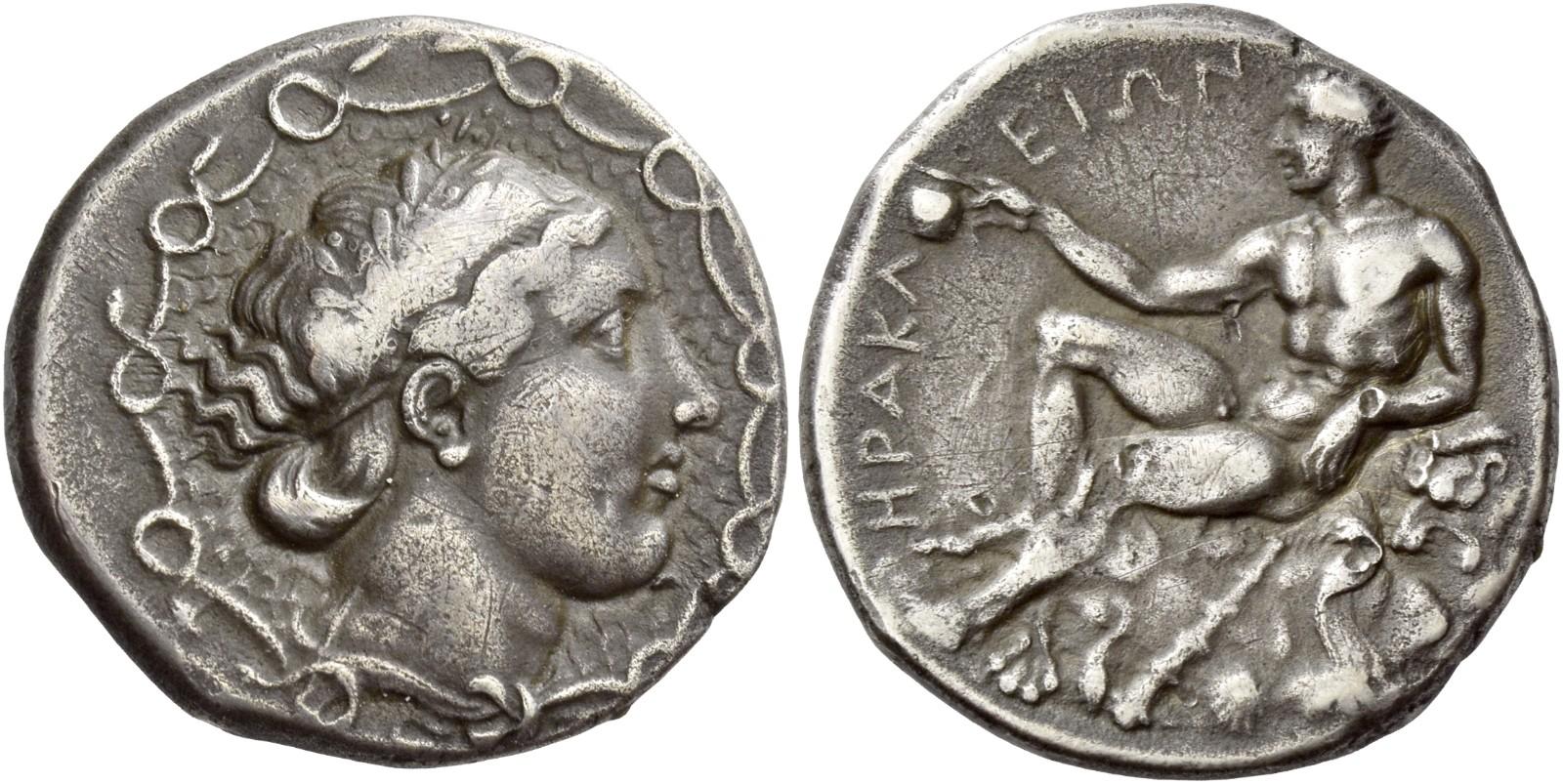Heraclea Lucaniae, silver, didrachms (female head/Heracles) (400-370 BCE)
From SILVER
400 BCE - 370 BCE Silver 149 kg
Description
| ObverseInscription or printing placed on the obverse.: | Female head (Athena?) right, wearing olive wreath. Background, aegis with intertwined snakes. |
| ReverseInscription or printing placed on the reverse.: | HPAKΛEIΩN (Greek).Heracles, naked, half-reclining on rock covered with lion's skin, holding a one-handled jug in outstretched right hand. At his left hand, club. Beneath it, a shell. |
Mint and issuing power
| MintIdentifies the place of manufacture or issue of a numismatic object.: | Heraclea Lucaniae | Ancient regionAncient region.: | Lucania | Modern countryModern country: Italy | AuthorityIdentifies the issuing power. The authority can be "pretended" when the name or the portrait of X is on the coin but he/she was not the issuing power. It can also be "uncertain" when there is no mention of X on the coin but he/she was the issuing power according to the historical sources: |
Chronology
| FromIdentifies the initial date in a range assigned in a numismatic context. | 400 BCE | toIdentifies the final date in a range assigned in a numismatic context.. | 370 BCE | PeriodTime period of the numismatic object.: Classical 480-323 BC |
Physical description
| MetalThe physical material (usually metal) from which an object is made.: | Silver |
Median weightMedian of the weights of numismatic objects (in grams). in grams | 7.50 | DenominationTerm indicating the value of a numismatic object. Examples: tetradrachm, chalkous, denarius.: | didrachm |
StandardStandard.: |
Image

AC 1 - Heraclea Lucaniae, silver, didrachms (400-370 BCE).jpg [1]
References
| Die study referencePublication of the study: | Work 19401Work 1940, n° 1-2 | ||
| Coin series referenceReference to coin series study: | Sear I2Sear I, n° 388, RQEMAC3RQEMAC, n° 1, HN Italy4HN Italy, n° 1362, HGC 15HGC 1, n° 976 | ||
| Coin series web referenceCoin series web references: | |||
Obverse dies distribution
| FrequencyFrequency of specimen in distribution. ᵖ | Number of obversesNumber of obverse dies. ᵖ (o) | % (o) | Number of coinsNumber of coins. (n) | % (n) | Die nameName(s) of the die(s). |
| 15 | 1 | 100 | 15 | 100 | 1 |
| Total | 1 of 1 | 100 | 15 of 15 | 100 |
Reverse dies distribution
no distribution is available
Quantification
| Number of obversesNumber of obverse dies. ᵖ (o) | 1 | Number of singletons (o1)The number of singleton coins. ᵖ | 0 |
| Number of reverse diesNumber of reverse dies. (r) | 2 | Number of coinsNumber of coins. (n) | 15 |
| Coins per obverse dieNumber of coins per obverse die. (n/o) | 15 | Coins per reverse dieNumber of coins per reverse die. (n/r) | 7.5 |
| Reverse per obverse ratioRatio of obverse dies divided by reverse dies. (r/o) | 2 | Percentage of singletons (o1)number of coins (n) divided by the number of singletons (o1) ᵖ | 0 % |
| Original number of dies (O) (Carter 1983 formula)The estimation of the number of coins according to Carter 1983 ᵖ | 0.99 | Coins struck if 20,000 as average productivity per dieCoins made if the average productivity for obverses (according to Carter) is 20,000. ᵖ | 19,800 |
| Original number of dies (O) (Esty 2011 formula)The estimation of the number of coins according to the singleton formula in Esty 2011 ᵖ (O) | 1.07 | Survival rate if 20,000 as average productivity per dieSurvival rate if average productivity is 20,000. ᵖ | 0.00076 |
| Coverage (o = % of O) (Esty 1984 formula)Esty 1984 - coverage (% of O) ᵖ (o = % of O) | 100% | Die productivity if survival rate 1/2,000Average productivity if survival rate is 1/2,000. ᵖ | 30,303.03 |
| Weight of silver (in kg) if 20,000 coins per die (O = Carter formula)Carter 1983 * Median weight * 20000 (*10 if gold or electrum) ᵖ | 149 kg <br /> 149 kg | Die productivity if survival rate 1/5,000Average productivity if survival rate is 1/5,000. ᵖ | 75,757.58 |
Remarks
Most likely one single workstation